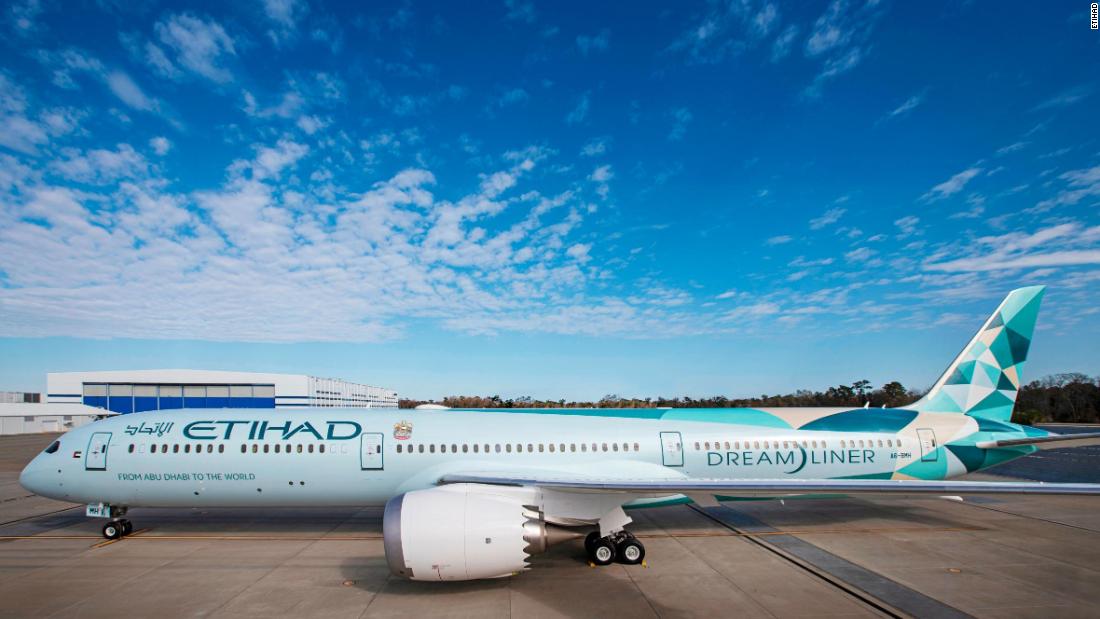The flights were part of a program called “Greenliner,” run by Etihad Airways, the national carrier of the United Arab Emirates, as a testbed for sustainable air travel solutions.
That’s why SAF is one of the key elements of the “Greenliner” program. “It’s essentially a call to action,” says Mariam AlQubaisi, head of sustainability at Etihad. “The idea came about in late 2019 to launch a message to the industry: let’s try everything possible to decarbonize.” The program is based around the Boeing 787 Dreamliner, but Etihad has a similar initiative, called Sustainable50, dedicated to the Airbus A350. Since its launch, Greenliner has championed the adoption of SAF and tackled issues such as plastic waste and inefficient flight routes.
Ethiad’s “Sustainable50” Airbus A350.
Etihad
The “Greenliner” moniker is often used to refer to a specific 787 aircraft, which AlQubaisi calls the program’s “mascot.” Unsurprisingly, it’s painted green — which she says is a way pre-empting accusations of greenwashing.
“Any project any airline would launch will always be scrutinized under the umbrella of greenwashing,” she explains. “Painting the aircraft green was a way to challenge that and say it is dedicated to a purpose. We’re owning up to our emissions: We’re saying yes, we’re a major emitter — but we’re doing something about it.”
A quick fix
The apparent absurdity highlights challenges with both SAF infrastructure and communicating green initiatives. The plane didn’t have SAF on board because current regulations prohibit commercial flights from using more than 50% SAF, as not all engines are certified for higher concentrations. Plus, not all airports have the infrastructure to use it, and the green fuel must come from a production facility relatively close to the airport to avoid canceling out the reduction in flight emissions with those coming from transportation.
So, Etihad purchased enough SAF to power the flight and delivered the fuel to Los Angeles International Airport, which has the necessary infrastructure and facilities. There, the SAF was integrated into the airport’s refueling system with traditional fuel, and used by whichever aircraft were refueling that day. This system is called “Book & Claim,” and it’s currently the only way for a flight to claim it’s using 100% SAF. The emissions are simply offset elsewhere, rather than on one specific flight.
Etihad’s “Greenliner” program tests out sustainable initiatives on this Boeing 787 Dreamliner.
Etihad
AlQubaisi calls it a “quick fix” until regulations change, but for SAF to become more widespread, more progress is required. “The price of SAF is four to five times that of conventional jet fuel and it’s limited in supply. Only two bodies are allowed to certify it, so until we have more and until governments intervene to incentivize production, SAF will continue to be limited,” she says.
Etihad has used SAF extensively in a series of “EcoFlights,” which employ the carrier’s 787 and A350 fleet to assess new sustainability initiatives. These culminated in the airline’s most environmentally friendly flight ever, a London Heathrow to Abu Dhabi service on October 23, 2021. The flight, Etihad says, achieved a 72% overall reduction in emissions by using 38% SAF (via “Book & Claim”) and adopted a host of other measures, such as reducing single-use plastic by 80% and delivering baggage via electric tractors.
It was also the first commercial flight to test a novel way to combat emissions, by using navigation and artificial intelligence to avoid the formation of contrails. These are vapor trails that form when ice crystals coalesce around the exhaust gasses emitted by aircraft engines, and result in temporary clouds that trap heat, contributing significantly to the warming effect of air travel. But modifying the plane’s route or altitude can help dramatically. “The warming you’re avoiding by simply adding a little more time to the journey is up to 60%, if not more,” says AlQubaisi. “What’s nice about this is that it’s done via specific algorithms that make the system become smarter the more we use it.”
A greener future?
Etihad’s “EcoFlights” have trialed a range of technologies and techniques aimed at reducing emissions, such as an optimized climb and a continuous descent, last-minute engine start-up, taxi procedures using a single engine, and washing the engine with a special foam that improves efficiency by reducing the build-up of deposits.
Smart navigation can help to reduce a single flight’s carbon footprint.
Etihad
There’s still a lot to be done, AlQubaisi says: “This is an industry that has had free rein on pollution for many years and it’s about time we own up to our responsibility to decarbonize.”
The key to achieving a greener aviation is everyone working toward it, she adds: “Hopefully you’ll hear of more airlines joining the Greeliner program, because it doesn’t matter who does it first — what matters is who does it better.
“We can do better together, because sustainability is not an area for competition, it’s an area for collaboration.”
